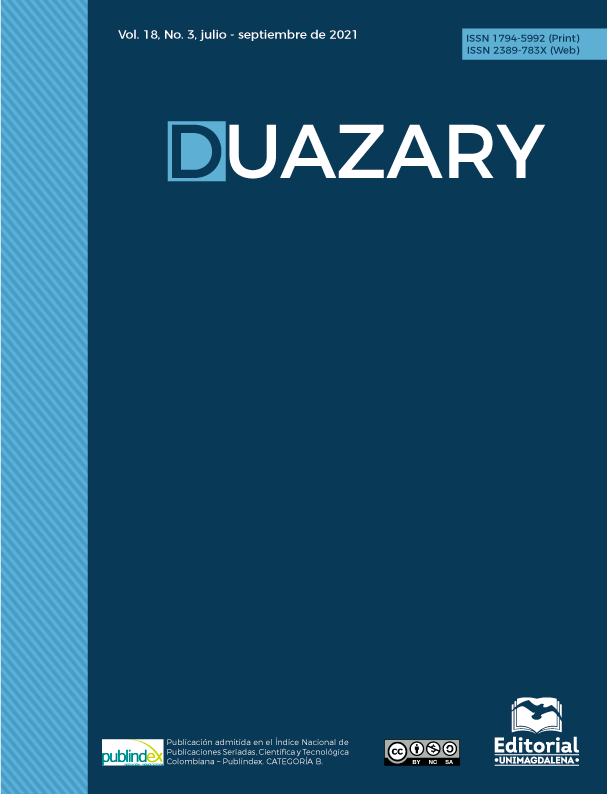Supervivencia de pacientes con cáncer de próstata en un hospital de Bogotá, Colombia 2008-2014
Contenido principal del artículo
Resumen
El cáncer de próstata es actualmente una de las principales patologías que afectan a los hombres. El objetivo del presente artículo fue estimar la supervivencia de los pacientes con cáncer de próstata de riesgo intermedio y alto pertenecientes al régimen especial de salud (militares). Se realizó un estudio de cohorte que estima la función de supervivencia con el método de Kaplan-Meier y el Hazard ratio (HR) en función de variables explicativas mediante un modelo de regresión de Cox. Los pacientes incluidos fueron diagnosticados por urología y/o confirmados con apoyos diagnósticos. No se incluyeron pacientes tratados para cáncer de próstata en otra institución o por tumores primarios diferentes a próstata y quienes consultaron para tomar una segunda opinión médica. Los pacientes de riesgo intermedio sobreviven en un 90% tanto a cinco como a siete años, y los de riesgo alto sobrevivieron en 35% y 30% a cinco y siete años, respectivamente, con una mediana de 28 meses. Este estudio permitió concluir que la supervivencia de los pacientes clasificados como riesgo intermedio es similar a la nacional e internacional; sin embargo, en los pacientes de alto riesgo la supervivencia es inferior respecto a otros países.
Descargas
Detalles del artículo

Esta obra está bajo una licencia internacional Creative Commons Atribución-NoComercial-CompartirIgual 4.0.
No se permite un uso comercial de la obra original ni de las posibles obras derivadas, la distribución de las cuales se debe hacer con una licencia igual a la que regula la obra original.
Citas
Ribal M, Mellado B. Guías de consenso para el manejo del cáncer de próstata resistente a castración en Catalunya. UOC; 2014.
Campá J, Mar B, Extramiana J, Arróspide A, Mar J. Supervivencia del cáncer de próstata avanzado en España según escala de Gleason, edad y estadio. Actas Urológicas Españolas. 2016 Oct; 40(8): 499-506. Doi: https://doi.org/10.1016/j.acuro.2016.03.0083
National Cancer Institute. Prostate Cancer Prevention (PDQ®)–Health Professional [Internet] [citado 15 sep 2019]. Disponible en: https://www.cancer.gov/types/prostate/hp/prostate-prevention-pdq
Pow-Sang M, Destefano V, Astigueta J, Castillo O, Gaona J, Santaella F, et al. Cáncer de próstata en Latinoamérica. Actas Urol Esp. 2009 Dic; 33(10): 1057-61. Doi: https://doi.org/10.1016/S0210-4806(09)73181-X
Ospina M, Huertas J, Montaño J, Rivillas J. Observatorio Nacional de Cáncer Colombia. Fac. Nac. Salud Pública [revista en la Internet]. 2015 May; 33(2): 262-76. Disponible en: https://revistas.udea.edu.co/index.php/fnsp/article/view/19044
Gutiérrez P, González S, Conde V. Influencia del protocolo diagnóstico y la edad en la tasa de incidencia de cáncer de próstata en Castilla y León según el registro nacional de 2010. Actas Urol Esp. 2021; 45(5): 383-90. Doi: https://doi.org/10.1016/j.acuro.2020.11.007
Lacny S, Wilson T, Clement F, Roberts D, Faris P, Ghali W, et al. Kaplan–Meier survival analysis overestimates cumulative incidence of health-related events in competing risk settings: a meta-analysis. Journal of Clinical Epidemiology. 2018 Oct; 93: 25-35. Doi: https://doi.org/10.1016/j.jclinepi.2017.10.006
Colombia. Ministerio de Salud. Resolución Número 8430 de 1993 [Internet]. Disponible en: https://www.minsalud.gov.co/sites/rid/Lists/BibliotecaDigital/RIDE/DE/DIJ/RESOLUCION-8430-DE-1993.PDF
Montero Granados R. Modelos de regresión lineal múltiple [Trabajo de grado Economía Aplicada]. España: Universidad de Granada. Facultad Ciencias Empresariales; 2016.
Allemani C, Weir H, Carreira H, Harewood R, Spika D, Wang X, et al. Global surveillance of cancer survival 1995-2009: Analysis of individual data for 25 676 887 patients from 279 population-based registries in 67 countries (Concord-2). Lancet. 2015; 385(9972): 977-1010. Doi: https://doi.org/10.1016/S0140-6736(14)62038-9
Villegas C, Chacón J, Sánchez T. Sobrevida en cáncer de próstata de una población del centro de Colombia 1997-2012. Acta Médica Colombiana. 2015; 40(2): 101-8. Doi: https://doi.org/10.36104/amc.2015.447
Restrepo J, Bravo L, García-Perdomo H, García L, Collazos P, Carbonell J. Incidencia, mortalidad y supervivencia al cáncer de próstata en Cali, Colombia, 1962-2011. Salud Pública Mex. 2014; 56(5): 440-7. Doi: https://doi.org/10.21149/spm.v56i5.7369
Yossepowitch O, Eggener S, Serio A, Carver B, Bianco F, Scardino P, et al. Secondary Therapy, Metastatic Progression, and Cancer-Specific Mortality in Men with Clinically High-Risk Prostate Cancer Treated with Radical Prostatectomy. Eur Urol. 2008; 53(5): 950-9. Doi: https://doi.org/10.1016/j.eururo.2007.10.008
Angulo J, Romero I, Díaz M, Enrech S, Díez R, Molina T. Supervivencia del cáncer de próstata resistente a la castración en la práctica clínica y el papel del tratamiento. Rev Colombiana de Cancerología. 2017 Jun; 21(2): 95-103. Doi: http://dx.doi.org/10.1016/j.rccan.2017.03.002
Yamamoto S, Kawakami S, Yonese J, Fujii Y, Urakami S, Kitsukawa S, et al. Long-term oncological outcome inmen with T3 prostate cancer: Radical prostatectomy versus external-beam radiation therapy at a single institution. Int J Clin Oncol. 2014; 19: 1085-91. Doi: https://doi.org/10.1007/s10147-013-0654-2
Abdollah F, Schmitges J, Sun M, Jeldres C, Tian Z, Briganti A, et al. Comparison of mortality outcomes after radical prostatectomy versus radiotherapy in patients with localized prostate cancer: A population-based analysis. Int J Urol. 2012; 19(9): 836-44. Doi: https://doi.org/10.1111/j.1442-2042.2012.03052.x
Neeple K, Stephenson A, Kallogjeri D, Michalski J, Grubb I, Strope S, et al. Mortality After Prostate Cancer Treatment with Radical Prostatectomy, External-Beam Radiation Therapy, or
Brachytherapy in Men Without Comorbidity. European Urology. 2013; 64(3): 372-8. Doi: https://doi.org/10.1016/j.eururo.2013.03.005
DeVita V, Hellman S, Rosenberg S. Cancer Principles & Practice of Oncology. 6.a edición. [Internet]. Philadelphia: Williams & Wilkins Publishers; 2011. Disponible en: https://oncouasd.files.wordpress.com/2014/09/cancer-principles-and-practice-of-oncology-6e.pdf
Rodríguez A, Gómez F, Álvarez J, Carballido J, Palou J, Solsona E, et al. Factores que predicen el desarrollo de metástasis óseas por cáncer de próstata: recomendaciones de seguimiento y opciones terapéuticas. Actas Urol Esp. 2014; 38(4): 263-9. Doi: http://dx.doi.org/10.1016/j.acuro.2013.09.002
Ferrís J, García J, Berbel O, Ortega J. Factores de riesgo constitucionales en el cáncer de próstata. Actas Urol Esp. 2011; 35(5): 282-8. Doi: https://doi.org/10.1016/j.acuro.2010.12.009
Segarra J, Millán F, Palou J, Villavicencio H. Factores pronósticos y tablas predictivas del cáncer de próstata clínicamente localizado. Actas Urol Esp. 2006; 30(6): 567-73. Doi: https://doi.org/10.1016/S0210-4806(06)73496-9
Pound C, Partin A, Epstein J, Walsh P. Prostate-Specific Antigen After Anatomic Radical Retropubic Prostatectomy: Patterns of Recurrence and Cancer Control. Urol Clin North Am. 1997 May; 24(2): 395-406. Doi: https://doi.org/10.1016/S0094-0143(05)70386-4
Oncology, American Society of Clinical. Cáncer de próstata: Estadísticas [Internet] [citado 11 abr 2020]. Disponible en: https://www.cancer.net/es/tipos-de-c%C3%A1ncer/c%C3%A1ncer-de-pr%C3%B3stata/estad%C3%ADsticas

